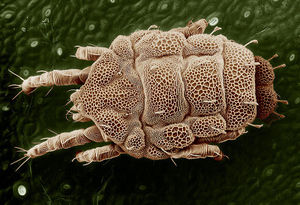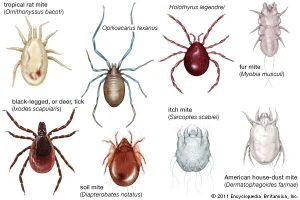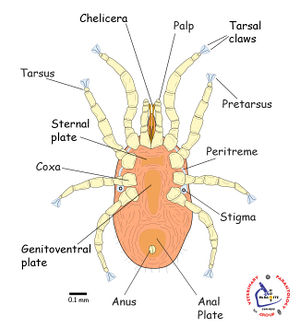Mites: Difference between revisions
No edit summary |
m The LinkTitles extension automatically added links to existing pages (https://github.com/bovender/LinkTitles). |
||
| (25 intermediate revisions by 3 users not shown) | |||
| Line 1: | Line 1: | ||
==Definition== | ==Definition== | ||
Mites are the most diverse of all arachnids, and among the oldest of all terrestrial animals. Fossils date mites from the early Devonian, nearly 400 million years ago | [[File:lorryia-formosa-mite.jpg|thumb|right|Lorryia formosa mite [5]]] | ||
Mites are the most diverse of all arachnids, and among the oldest of all terrestrial animals. Fossils date mites from the early Devonian, nearly 400 million years ago [1.] Belonging to the class Archnida, the term "mite" refers to the several groups in the subclass [[Acari]], but it is not a clade, and excludes the ticks. Mites and ticks are similarly characterized by their bodies being divided into two parts, named the gnathosoma and idiosoma. The three major lineages of mites are recognized as Opilioacariformes, Acariformes and Parasitiformes [1]. 45,000 species of mites have been described, which is believed to be only small 5% of the number of species estimated to be alive today. Mites can be found throughout the planet in every kind of habitat from the sea to freshwater, and in all terrestrial habitats, including [[soil]], tree canopy, rotting woods, tree hollows, nests of vertebrates, dung and anthills [8]. In most studies, the scientists use the Berlese-Tullgren funnel to extract [[microarthropods]] from soil samples ([[Soil Sampling Methods]]). The soil sample size is often about 5 cm in diameter and 5 cm depth. Most mites in native soils occur in the top [[Soil Horizons]] [8]. | |||
==Characteristics== | ==Characteristics== | ||
''A Manual of Acarology'' has defined Acari to have the following characteristics [1]: | |||
*Hexapod prelarva (lost in Parasitiformes and many derived Acariformes) | *[[Hexapod]] prelarva (lost in Parasitiformes and many derived Acariformes) | ||
*Hexapod larval stage | *Hexapod larval stage | ||
| Line 25: | Line 26: | ||
==Taxonomy== | ==Taxonomy== | ||
Acari have been variously ranked as a group made up of one to seven or more distinct orders. The orders comprise approximately half of the described arachnid diversity. Molecular information from ribosomal DNA is used to expose relationships between groups. The 18 S rRNA gene provides information on relationships among phyla and superphyla, while the ITS2, and the 18S ribosomal RNA and 28S ribosomal RNA genes, show relationships at deeper levels. | [[File:diversity of acari.jpg|thumb|right|Diversity of Acari [6]]] | ||
Acari have been variously ranked as a group made up of one to seven or more distinct orders. The orders comprise approximately half of the described arachnid [[diversity]]. Molecular information from ribosomal DNA is used to expose relationships between groups. The 18 S rRNA gene provides information on relationships among phyla and superphyla, while the ITS2, and the 18S ribosomal RNA and 28S ribosomal RNA genes, show relationships at deeper levels [2]. Recent research has suggested that Acari is polyphyletic [3]. ''A Manual of Acarology'' uses a system of six orders, grouped into three superorders to classify Acari [2]: | |||
*Superorder Opilioacariformes – a small order of large mites with about 20 known species | *Superorder Opilioacariformes – a small order of large mites with about 20 known species | ||
| Line 31: | Line 35: | ||
**Holothyrida - predatory mites from the southern hemisphere | **Holothyrida - predatory mites from the southern hemisphere | ||
**Ixodida – hard ticks and soft ticks | **Ixodida – hard ticks and soft ticks | ||
**Mesostigmata – excess of 65 families and 10,000 described species, including bird mites, phytoseiid mites | **[[Mesostigmata]] – excess of 65 families and 10,000 described species, including bird mites, phytoseiid mites | ||
***Trigynaspida - large, diverse order | ***Trigynaspida - large, diverse order | ||
***Monogynaspida - diverse order of parasitic and predatory mites | ***Monogynaspida - diverse order of parasitic and predatory mites | ||
| Line 37: | Line 41: | ||
**Trombidiformes – plant parasitic mites (spider mites, peacock mites, gall mites, red-legged earth mites, etc.), snout mites, chiggers, hair follicle mites, velvet mites, water mites, etc. | **Trombidiformes – plant parasitic mites (spider mites, peacock mites, gall mites, red-legged earth mites, etc.), snout mites, chiggers, hair follicle mites, velvet mites, water mites, etc. | ||
***Sphaerolichida - small order of mites containing two families | ***Sphaerolichida - small order of mites containing two families | ||
***Prostigmata - large order of sucking mites | ***[[Prostigmata]] - large order of sucking mites | ||
**Sarcoptiformes | **Sarcoptiformes | ||
***Oribatida – oribatid mites, beetle mites, armored mites (also cryptostigmata) | ***[[Oribatida]] – oribatid mites, beetle mites, armored mites (also cryptostigmata) | ||
***Astigmatina – stored product, fur, feather, dust, and human itch mites, etc. | ***[[Astigmatina]] – stored product, fur, feather, dust, and human itch mites, etc. | ||
==Anatomy== | |||
[[File:mitie.jpg|thumb|right|Basic Mite Anatomy [7]]] | |||
Mite size varies from 0.1 mm to 10 mm in length. They are most closely related to spiders than [[insects]]. They have the same characteristics of jointed legs and a chitinous exoskeleton. Acari have an open circulating system, ventral nerve cord, alimentary canal and striated muscles and may also possess Malpighian tubules. Acari lack antennae and mandibles [4]. The acarine body is divided into gnathosoma and idiosoma. The gnathosoma is the part of the body of the Acari comprising the mouth and feeding parts, and the idiosoma bears the legs, the genital and anal openings, and an assortment of tactile and sensory structures. | |||
==See also== | |||
*[[Microorganisms]] | |||
*[[Organisms]] | |||
*[[Smaller Creatures]] | |||
*[[Animals]] | |||
*[[Nematodes]] | |||
*[[Springtail]] | |||
*[[Soil organisms]] | |||
*[[Tardigrades]] | |||
==References== | |||
[1] | |||
Walter, David Evans, Gerald Krantz, and Evert Lindquist. 1996. Acari. The Mites. Version 13 December 1996. http://tolweb.org/Acari/2554/1996.12.13 inThe Tree of Life Web Project, http://tolweb.org/ | |||
[2] | |||
Pepato, Almir R, et al. “Phylogenetic Position of the Acariform Mites: Sensitivity to Homology Assessment under Total Evidence.” BMC Evolutionary Biology, BioMed Central, 2 Aug. 2010, bmcevolbiol.biomedcentral.com/articles/10.1186/1471-2148-10-235. | |||
[3] | |||
Sanggaard, Kristian W.; Bechsgaard, Jesper S.; Fang, Xiaodong (6 May 2014). "Spider genomes provide insight into composition and evolution of venom and silk". Nature Communications. 5: 3765. Bibcode:2014NatCo...5E3765S. doi:10.1038/ncomms4765. PMC 4273655 Freely accessible. PMID 24801114. | |||
[4] | |||
Dhooria M.S. (2016) Morphology and Anatomy of Acari. In: Fundamentals of Applied Acarology. Springer, Singapore | |||
[5] | |||
“Acari.” Acari - Entomologists' Glossary - Amateur Entomologists' Society (AES), www.amentsoc.org/insects/glossary/terms/acari. | |||
[6] | |||
Wilson, Nixon A. “Acarid.” Encyclopædia Britannica, Encyclopædia Britannica, Inc., 27 Dec. 2017, www.britannica.com/animal/acarid. | |||
[7] | |||
NCSU Veterinary Parasitology, parasitology.cvm.ncsu.edu/vmp930/keys/mites/miteterms.html. | |||
[8] | |||
Gulvik, M. "Mites (Acari) as indicators of soil biodiversity and land use monitoring: a review." Polish Journal of [[Ecology]] 55.3 (2007): 415. | |||
Latest revision as of 13:45, 1 May 2025
Definition

Mites are the most diverse of all arachnids, and among the oldest of all terrestrial animals. Fossils date mites from the early Devonian, nearly 400 million years ago [1.] Belonging to the class Archnida, the term "mite" refers to the several groups in the subclass Acari, but it is not a clade, and excludes the ticks. Mites and ticks are similarly characterized by their bodies being divided into two parts, named the gnathosoma and idiosoma. The three major lineages of mites are recognized as Opilioacariformes, Acariformes and Parasitiformes [1]. 45,000 species of mites have been described, which is believed to be only small 5% of the number of species estimated to be alive today. Mites can be found throughout the planet in every kind of habitat from the sea to freshwater, and in all terrestrial habitats, including soil, tree canopy, rotting woods, tree hollows, nests of vertebrates, dung and anthills [8]. In most studies, the scientists use the Berlese-Tullgren funnel to extract microarthropods from soil samples (Soil Sampling Methods). The soil sample size is often about 5 cm in diameter and 5 cm depth. Most mites in native soils occur in the top Soil Horizons [8].
Characteristics
A Manual of Acarology has defined Acari to have the following characteristics [1]:
- Hexapod prelarva (lost in Parasitiformes and many derived Acariformes)
- Hexapod larval stage
- Three octopod nymphal stages (variously abbreviated in derived taxa)
- Gnathosoma delimited by a circumcapitular suture
- Palpcoxal endites fused medially forming a hypostome
- Hypostome with rutella or corniculi (lost in many derived Acariformes)
- Loss of external evidence of opisthosomal segmentation, i.e. without tergites or sternites
- Ingestion of particulate food (lost in many derived taxa)
Taxonomy

Acari have been variously ranked as a group made up of one to seven or more distinct orders. The orders comprise approximately half of the described arachnid diversity. Molecular information from ribosomal DNA is used to expose relationships between groups. The 18 S rRNA gene provides information on relationships among phyla and superphyla, while the ITS2, and the 18S ribosomal RNA and 28S ribosomal RNA genes, show relationships at deeper levels [2]. Recent research has suggested that Acari is polyphyletic [3]. A Manual of Acarology uses a system of six orders, grouped into three superorders to classify Acari [2]:
- Superorder Opilioacariformes – a small order of large mites with about 20 known species
- Superorder Parasitiformes – ticks and a variety of mites
- Holothyrida - predatory mites from the southern hemisphere
- Ixodida – hard ticks and soft ticks
- Mesostigmata – excess of 65 families and 10,000 described species, including bird mites, phytoseiid mites
- Trigynaspida - large, diverse order
- Monogynaspida - diverse order of parasitic and predatory mites
- Superorder Acariformes – contains over 300 families and over 30, 000 described species
- Trombidiformes – plant parasitic mites (spider mites, peacock mites, gall mites, red-legged earth mites, etc.), snout mites, chiggers, hair follicle mites, velvet mites, water mites, etc.
- Sphaerolichida - small order of mites containing two families
- Prostigmata - large order of sucking mites
- Sarcoptiformes
- Oribatida – oribatid mites, beetle mites, armored mites (also cryptostigmata)
- Astigmatina – stored product, fur, feather, dust, and human itch mites, etc.
- Trombidiformes – plant parasitic mites (spider mites, peacock mites, gall mites, red-legged earth mites, etc.), snout mites, chiggers, hair follicle mites, velvet mites, water mites, etc.
Anatomy

Mite size varies from 0.1 mm to 10 mm in length. They are most closely related to spiders than insects. They have the same characteristics of jointed legs and a chitinous exoskeleton. Acari have an open circulating system, ventral nerve cord, alimentary canal and striated muscles and may also possess Malpighian tubules. Acari lack antennae and mandibles [4]. The acarine body is divided into gnathosoma and idiosoma. The gnathosoma is the part of the body of the Acari comprising the mouth and feeding parts, and the idiosoma bears the legs, the genital and anal openings, and an assortment of tactile and sensory structures.
See also
References
[1] Walter, David Evans, Gerald Krantz, and Evert Lindquist. 1996. Acari. The Mites. Version 13 December 1996. http://tolweb.org/Acari/2554/1996.12.13 inThe Tree of Life Web Project, http://tolweb.org/
[2] Pepato, Almir R, et al. “Phylogenetic Position of the Acariform Mites: Sensitivity to Homology Assessment under Total Evidence.” BMC Evolutionary Biology, BioMed Central, 2 Aug. 2010, bmcevolbiol.biomedcentral.com/articles/10.1186/1471-2148-10-235.
[3] Sanggaard, Kristian W.; Bechsgaard, Jesper S.; Fang, Xiaodong (6 May 2014). "Spider genomes provide insight into composition and evolution of venom and silk". Nature Communications. 5: 3765. Bibcode:2014NatCo...5E3765S. doi:10.1038/ncomms4765. PMC 4273655 Freely accessible. PMID 24801114.
[4] Dhooria M.S. (2016) Morphology and Anatomy of Acari. In: Fundamentals of Applied Acarology. Springer, Singapore
[5] “Acari.” Acari - Entomologists' Glossary - Amateur Entomologists' Society (AES), www.amentsoc.org/insects/glossary/terms/acari.
[6] Wilson, Nixon A. “Acarid.” Encyclopædia Britannica, Encyclopædia Britannica, Inc., 27 Dec. 2017, www.britannica.com/animal/acarid.
[7] NCSU Veterinary Parasitology, parasitology.cvm.ncsu.edu/vmp930/keys/mites/miteterms.html.
[8] Gulvik, M. "Mites (Acari) as indicators of soil biodiversity and land use monitoring: a review." Polish Journal of Ecology 55.3 (2007): 415.